AMD’s 5 GHz Turbo CPU in Retail: The FX-9590 and ASRock 990FX Extreme9 Review
by Ian Cutress on August 9, 2014 8:00 AM ESTMany thanks to...
We must thank the following companies for kindly providing hardware for our test bed:
Thank you to OCZ for providing us with PSUs and SSDs.
Thank you to G.Skill and ADATA for providing us with memory kits.
Thank you to Corsair for providing us with an AX1200i PSU, Corsair H80i CLC and DRAM.
Thank you to ASUS for providing us with the AMD HD7970 GPUs and some IO Testing kit.
Thank you to MSI for providing us with the NVIDIA GTX 770 Lightning GPUs.
Thank you to Rosewill for providing us with PSUs and RK-9100 keyboards.
Thank you to ASRock for providing us with some IO testing kit.
Test Setup
| Test Setup | |
| Processor |
AMD FX-9590 4 Modules, 8 Threads, 4.7 GHz, 5.0 GHz Turbo |
| Motherboards | ASRock 990FX Extreme9 |
| Cooling |
Corsair H80i Thermalright TRUE Copper |
| Power Supply |
OCZ 1250W Gold ZX Series Corsair AX1200i Platinum PSU |
| Memory | G.Skill RipjawsZ 4x4 GB DDR3-1866 9-11-9 Kit |
| Memory Settings | DDR3-1866 8-9-9 |
| Video Cards | MSI GTX 770 Lightning 2GB (1150/1202 Boost) |
| Video Drivers | NVIDIA Drivers 337 |
| Hard Drive | OCZ Vertex 3 256GB |
| Optical Drive | LG GH22NS50 |
| Case | Open Test Bed |
| Operating System | Windows 7 64-bit SP1 |
| USB 2/3 Testing | OCZ Vertex 3 240GB with SATA->USB Adaptor |
| WiFi Testing | D-Link DIR-865L 802.11ac Dual Band Router |
System Benchmarks
Power Consumption
Power consumption was tested on the system as a whole with a wall meter connected to the OCZ 1250W power supply, while in a single MSI GTX 770 Lightning GPU configuration. This power supply is Gold rated, and as I am in the UK on a 230-240 V supply, leads to ~75% efficiency > 50W, and 90%+ efficiency at 250W, which is suitable for both idle and multi-GPU loading. This method of power reading allows us to compare the power management of the UEFI and the board to supply components with power under load, and includes typical PSU losses due to efficiency. These are the real world values that consumers may expect from a typical system (minus the monitor) using this motherboard.
While this method for power measurement may not be ideal, and you feel these numbers are not representative due to the high wattage power supply being used (we use the same PSU to remain consistent over a series of reviews, and the fact that some boards on our test bed get tested with three or four high powered GPUs), the important point to take away is the relationship between the numbers. These boards are all under the same conditions, and thus the differences between them should be easy to spot.
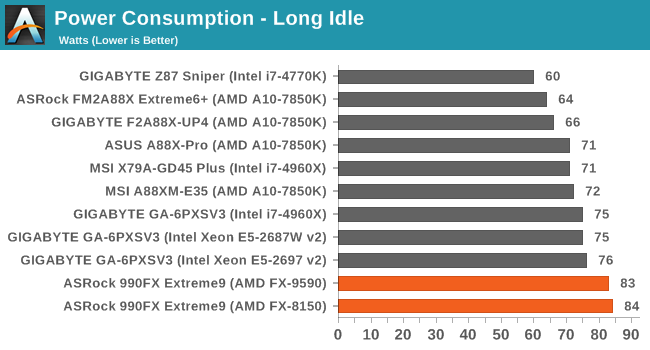
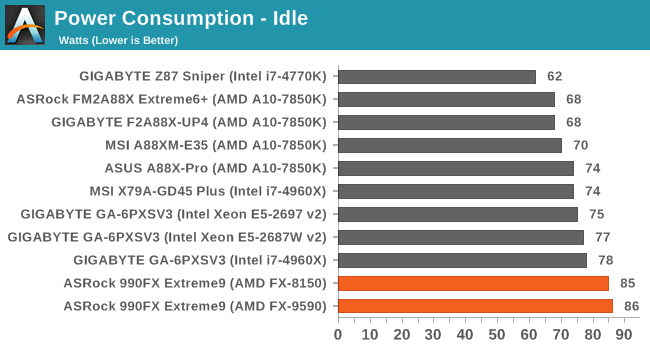
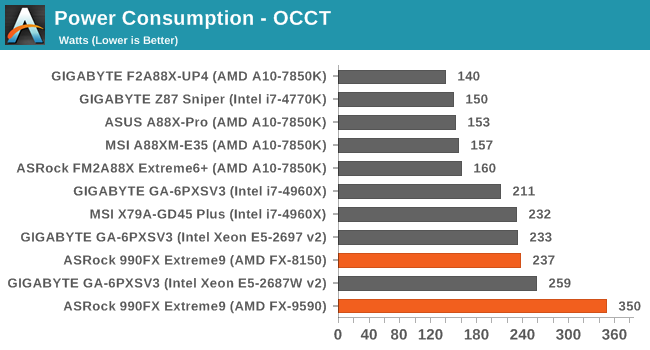
The added power draw of the FX-9590 is quite clear, showing 350W for the full system during a heavy CPU load. However, the idle power draw of the CPU is similar to that of the FX-8150.
Windows 7 POST Time
Different motherboards have different POST sequences before an operating system is initialized. A lot of this is dependent on the board itself, and POST boot time is determined by the controllers on board (and the sequence of how those extras are organized). As part of our testing, we are now going to look at the POST Boot Time - this is the time from pressing the ON button on the computer to when Windows 7 starts loading. (We discount Windows loading as it is highly variable given Windows specific features.) These results are subject to human error, so please allow +/- 1 second in these results.
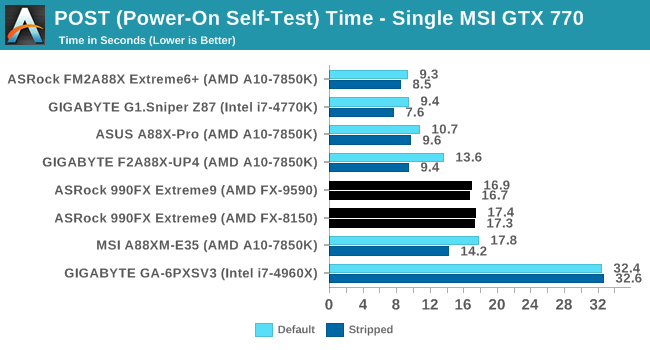
The FX-9590 afforded a shorter POST time than the FX-8150, although both are north of 16 seconds.
Rightmark Audio Analyzer 6.2.5
The premise behind Rightmark:AA is to test the input and output of the audio system to determine noise levels, range, harmonic distortion, stereo crosstalk and so forth. Rightmark:AA should indicate how well the sound system is built and isolated from electrical interference (either internally or externally). For this test we connect the Line Out to the Line In using a short six inch 3.5mm to 3.5mm high-quality jack, turn the OS speaker volume to 100%, and run the Rightmark default test suite at 192 kHz, 24-bit. The OS is tuned to 192 kHz/24-bit input and output, and the Line-In volume is adjusted until we have the best RMAA value in the mini-pretest. We look specifically at the Dynamic Range of the audio codec used on board, as well as the Total Harmonic Distortion + Noise.
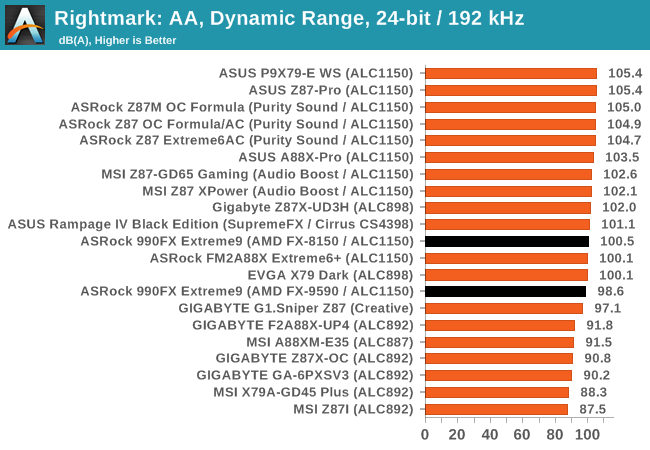
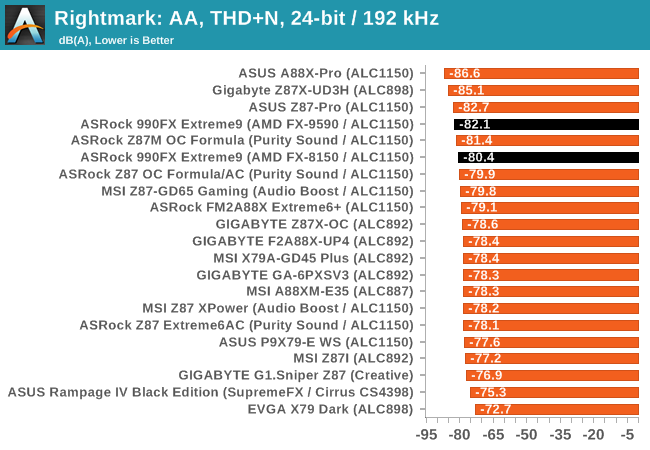
USB Backup
For this benchmark, we run CrystalDiskMark to determine the ideal sequential read and write speeds for the USB port using our 240 GB OCZ Vertex3 SSD with a SATA 6 Gbps to USB 3.0 converter. Then we transfer a set size of files from the SSD to the USB drive using DiskBench, which monitors the time taken to transfer. The files transferred are a 1.52 GB set of 2867 files across 320 folders – 95% of these files are small typical website files, and the rest (90% of the size) are the videos used in the WinRAR test. In an update to pre-Z87 testing, we also run MaxCPU to load up one of the threads during the test which improves general performance up to 15% by causing all the internal pathways to run at full speed.
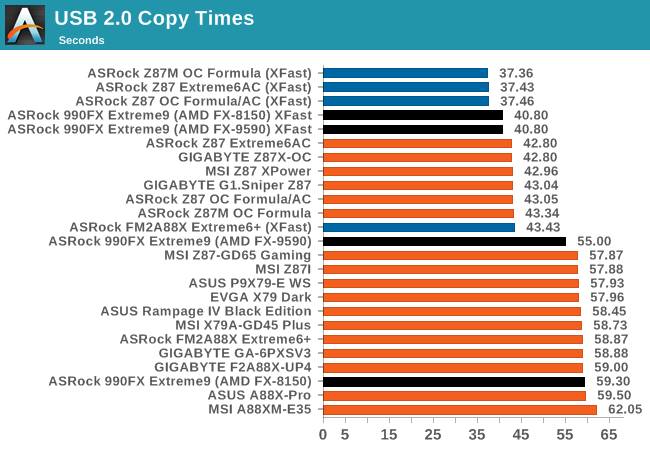
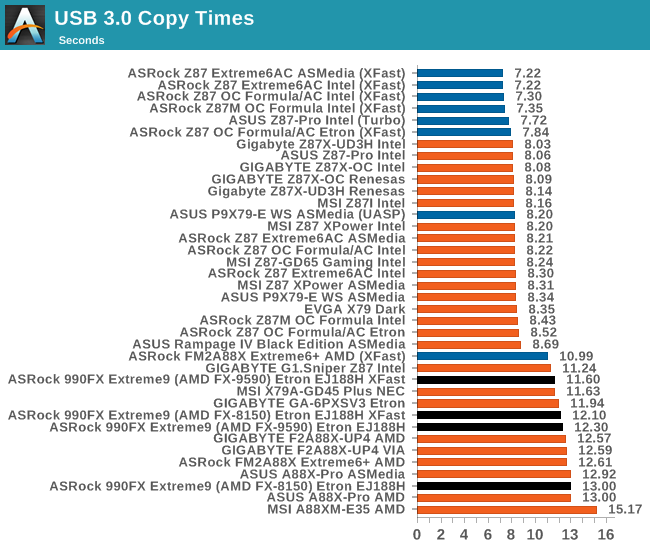
The increase in CPU speed of the FX-9590 gives a measured improvement in standard USB copy times – saving 4.3 seconds over the FX-8150 for USB 2.0 transfers. However using XFast USB eliminated that difference completely. For USB 3.0 transfers, using the Etron controller put a consistent advantage on the side of the FX-9590.
DPC Latency
Deferred Procedure Call latency is a way in which Windows handles interrupt servicing. In order to wait for a processor to acknowledge the request, the system will queue all interrupt requests by priority. Critical interrupts will be handled as soon as possible, whereas lesser priority requests, such as audio, will be further down the line. So if the audio device requires data, it will have to wait until the request is processed before the buffer is filled. If the device drivers of higher priority components in a system are poorly implemented, this can cause delays in request scheduling and process time, resulting in an empty audio buffer – this leads to characteristic audible pauses, pops and clicks. Having a bigger buffer and correctly implemented system drivers obviously helps in this regard. The DPC latency checker measures how much time is processing DPCs from driver invocation – the lower the value will result in better audio transfer at smaller buffer sizes. Results are measured in microseconds and taken as the peak latency while cycling through a series of short HD videos - less than 500 microseconds usually gets the green light, but the lower the better.
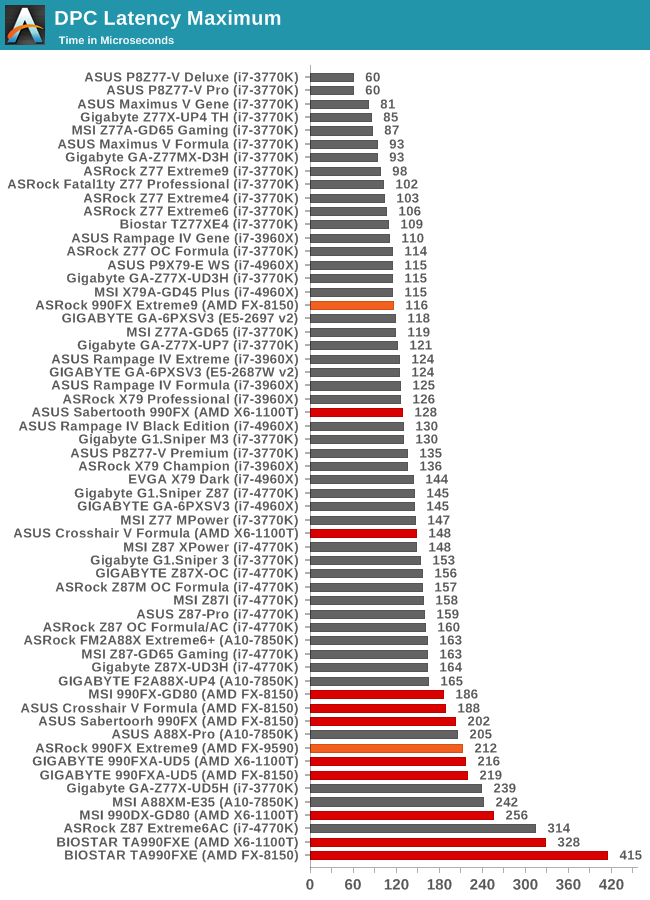
In a surprising twist, it would seem the FX-9590 has a disadvantage for DPC latency. I would have expected the faster processor to have the lower result, but one might speculate that the BIOS is tuned more for the mainstream processors such as the FX-8150. The chipset might also be geared more to the FX-8150 as it was the earlier generation compared to the FX-9590.










146 Comments
View All Comments
Budburnicus - Wednesday, January 14, 2015 - link
Umm, it is QUITE possible to get a SandyBridge to 5 GHz, in fact I have my i7-2600K rock stable at 4.7 GHz (where my Haswell i7-5930k is 4.4) - and it TOTALLY SPANKS this POS FX 9590! Less power, same clock speed, MUCH higher performance!AT is being TOO EASY on AMD, not too harsh! This CPU is not a "win" in any sense!
bebimbap - Saturday, August 9, 2014 - link
No matter what any one that loves this FX-9590 says, this processor is just an exercise in gluttony, and devolution.I have been spoiled by computer evolution. coming from the commodore/Macintosh/SX286 days. you appreciate a few things. such as noise/heat/size reduction of modern systems.
50-80w cpus are quiet, compared to the pentium4 days.... or Hairdryer days...
SSDs are silent,
modern HDDs are basically silent, compared to 40MB drives and 3.5/5.25 floppies and don't forget the stack of floppies you had in the drawer instead of a single USB stick.
modern gpus not oc'd are quiet, still remember the hiss of my gforce3Ti
CRTs - actually have a noise when you turn them on, some buzz when in use... and don't forget the size.
case- you either had a monster of a case that would break your table if you put it on it, or a fugly thing that you wanted to hide under the table.
overall the heat produced compared to a 19" crt + pentium4/thoroughbred + 9800XT compared to a modern system also let you get rid of the window AC unit reducing a lot of noise.
so i am spoiled because i can now have a system where i'm not sweating like a pig and going deaf while playing my favorite game or browsing the web. I don't need a 1000w speaker system to hear the gunshots clearly over my cpu/gpu/psu fans or window AC unit.
I no longer need a computer be a 4in1 device that acts as a heater, a LOUD white noise generator, an air filter, and computer. It should be similar to a BMW-M5, everyday comfort and driveability but grunt when you want it, but of course with better fuel economy.
Leyawiin - Saturday, August 9, 2014 - link
This article makes me feel good about the FX-6300 @ 4.5 Ghz I have. At least with the games they chose to benchmark I'm doing fine.siberus - Saturday, August 9, 2014 - link
Any chance we could get some testing with radeon gpu's using mantle ? :) would be pretty neat to see how some of the older/lower tiered cpu's break down. Unless you guys have done something like that already in another article then I apologize for asking.monstercameron - Saturday, August 9, 2014 - link
this cpu just chew through integer workloads, faster than a 4770k, where it fails is every thing else. I reckon a well optimized program written directly[fma?] for it would haul ass!resination - Saturday, August 9, 2014 - link
This is THE processor for the "rolling coal" set.CSammy - Saturday, August 9, 2014 - link
Pathetic. The cover might as well be Intel pissing on this AMD processor, because that is quite literally the truth in nearly every single aspect.TiGr1982 - Saturday, August 9, 2014 - link
Note that there is no recent Devil's Canyon Core i7-4790K here - this one, being around 13% faster than i7-4770K in CPU-bound tasks, would make the FX to look even less relevant.TheinsanegamerN - Saturday, August 9, 2014 - link
"AMD clearly does care about the performance market"yeah, thats why they couldnt even be bothered to use the new kaveri cores, instead rehashing an old piledriver cpu with higher clocks and a TDP that puts netburst to shame. all the while, performing sligtly slower then a intel cpu with a third the tdp and running 1.5 GHz slower.
They care about the performance market so much, that they put this chip on the 3 year old AM3+ platform, rather than the new FM2+ platform, just so we can use old chipsets with feature sets from 2011.
And it costs as much as a core i7.
CLEARLY, AMD still cares about the performance market.
TiGr1982 - Saturday, August 9, 2014 - link
I perfectly understand your sarcasm :)I guess, it was something like that: AMD did not and does not have the resources and/or desire to invest into pure many-module CPUs beyond Piledriver FX CPU. So, from the engineering standpoint, they stopped there.
But then the marketing stepped in and said: "We need a faster CPU to brag. Because we aren't developing a new one, can you boost the current one?" And the engineering team said "Yes... Okay...". And they did. :)